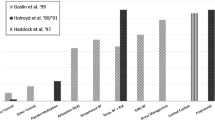Abstract
The impact of migraine is substantial for both the individual who suffers from it and society in general in terms of lost work hours, medication costs and healthcare usage. Many different forms of treatment are available for migraine, including biobehavioural approaches such as relaxation training and biofeedback.
Research regarding the efficacy of these nonpharmacological treatments has been extensive and consistently demonstrates lasting success with the use of the skills taught in treatment. Such treatment approaches have demonstrated effectiveness even when delivered in as few as 2 or 3 sessions with a therapist, thus substantially reducing the cost of treatment. Other treatment formats such as group and no-contact therapies have demonstrated success as well.
This article reviews the efficacy and cost efficiency of minimal-contact biobehavioural treatments for migraine as outlined in the research literature. Strictly self-help approaches are also reviewed, and resources for self-help information are discussed. The research indicates that such time-limited and focused treatment approaches are highly effective with select patients; however, there is a lack of research specifying the specific types of patients with migraine who benefit the most from these approaches. Future research needs to address this issue in order to provide the most efficacious and cost-effective treatments for all patients with migraine.




Similar content being viewed by others
References
Rasmussen BK, Breslau N. Epidemiology. In: Olesen J, Tfelt-Hansen P, Welch KMA, editors. The headaches. New York: Raven, 1993: 169–77
de Lissovoy G, Lazarus SS. The economic cost of migraine. Neurology 1994; 44 Suppl. 4: S56–62
Clouse JC, Osterhaus JT. Healthcare resource use and costs associated with migraine in a managed care setting. Ann Pharmacother 1994; 28: 659–64
Blanchard EB. Psychological treatment of benign headache disorders. J Consult Clin Psychol 1992; 60(4): 537–51
Silberstein SD, Rosenberg J. Multispeciality consensus on diagnosis and treatment of headache. Neurology 2000; 54: 1553
Blanchard EB, Theobald DE, Williamson DA, et al. Temperature biofeedback in the treatment of migraine headaches. Arch Gen Psychiatry 1978; 35: 581–8
Blanchard EB, Andrasik F, Neff DF, et al. Biofeedback and relaxation training with three kinds of headache: treatment effects and their prediction. J Consult Clin Psychol 1982; 50: 562–75
Haddock CK, Rowan AB, Andrasik F, et al. Home-based behavioral treatments for chronic benign headache: a meta-analysis of controlled trials. Cephalalgia 1997; 17(2): 113–8
Jurish SE, Blanchard EB, Andrasik F, et al. Home-versus clinicbased treatment of vascular headache. J Consult Clin Psychol 1983; 51(5): 743–51
Blanchard EB, Andrasik F, Appelbaum KA, et al. The efficacy and cost-effectiveness of minimal-therapist-contact, nondrug treatments of chronic migraine and tension headache. Headache 1985; 25: 214–20
Blanchard EB, Appelbaum KA, Nicholson NL, et al. Acontrolled evaluation of the addition of cognitive therapy to a home-based biofeedback and relaxation treatment of vascular headache. Headache 1990; 30(6): 371–6
Richardson GM, McGrath PJ. Cognitive behavioral therapy for migraine headaches: a minimal therapist contact approach versus a clinic-based approach. Headache 1989; 29: 352–7
Holroyd KA, Holm JE, Hursey KG, et al. Recurrent vascular headache: home-based behavioral treatment versus abortive pharmacological treatment. J Consult Clin Psychol 1988; 56: 218–23
Holroyd KA, Nash JM, Pingel JD, et al. A comparison of pharmacological (amitriptyline HCl) and nonpharmacological (cognitive-behavioral) therapies for chronic tension headaches. J Consult Clin Psychol 1991; 59(3): 387–93
Holroyd KA, France JL, Cordingley GE, et al. Enhancing the effectiveness of relaxation-thermal biofeedback training with Propranolol hydrochloride. J Consult Clin Psychol 1991; 59(3): 387–93
Guarnieri P, Blanchard EB. Evaluation of home-based thermal biofeedback treatment of pediatric migraine. Biofeedback Self Regul 1990; 15(2): 179–84
Griffiths JD, Martin PR. Clinical- versus home-based treatment formats for children with chronic headache. Br J Health Psychol 1996; 1: 151–66
Allen KD, McKeen LR. Home-based multicomponent treatment of pediatric migraine. Headache 1991; 31: 467–72
Scharff L, Marcus DA, Turk DC. Maintenance of effects in the nonmedical treatment of headache during pregnancy. Headache 1996; 36(5): 285–90
Rowan AB, Andrasik F. Efficacy and cost-effectiveness of minimal therapist contact treatments of chronic headaches: a review. Behav Ther 1996; 27: 207–34
Holroyd KA, Holm JF, Penzien DB, et al. Long-term maintenance of improvements achieved with (abortive) pharmacological and nonpharmacological treatments for migraine. Biofeedback Self Regul 1989; 14(4): 301–8
Williamson DA, Monguillot JE, Jarrell MP, et al. Relaxation for the treatment of headache: controlled evaluation of two group programs. Behav Modif 1984; 8(3): 407–24
Scharff L, Marcus DA. Interdisciplinary outpatient group treatment of intractable headache. Headache 1994; 34: 73–8
Kohlenberg RJ, Cahn T. Self-help treatment for migraine headaches: acontrolled outcome study. Headache 1981; 21: 196–200
de Bruijn-Kofman AT, van de Wiel H, Groenman NH, et al. Effects of a mass media behavioral treatment for chronic headache: a pilot study. Headache 1997; 37: 415–20
McGrath PJ, Humphreys P, Keene D, et al. The efficacy and efficiency of a self-administered treatment for adolescent migraine. Pain 1992; 49: 321–4
Gould RA, Clum GA. A meta-analysis of self-help treatment approaches. Clin Psychol Rev 1993; 13: 169–86
Hudzinski LG, Levenson H. Biofeedback behavioral treatment of headache with locus of control pain analysis: a 20-month retrospective study. Headache 1985; 25: 380–6
Arena JG, Hannah SL, Bruno GM, et al. Electromyographic biofeedback training for tension headache in the elderly: a prospective study. Biofeedback Self Regul 1991; 16(4): 379–90
Kabela E, Blanchard EB, Appelbaum KA, et al. Self-regulatory treatment of headache in the elderly. Biofeedback Self Regul 1989; 14(3): 219–28
Primavera JP, Kaiser RS. Non-pharmacological treatment of headache: is less more? Headache 1992; 32: 393–5
Acknowledgements
Financial support for the first author (Lisa Scharff) was provided by a grant from the National Institutes of Health/National Institute of Child Health and Development (HD38647-01).
Author information
Authors and Affiliations
Corresponding author
Rights and permissions
About this article
Cite this article
Scharff, L., Etherage, J. The Role of Minimal- and No-Contact Behavioural Treatments in Migraine. Dis-Manage-Health-Outcomes 8, 313–325 (2000). https://doi.org/10.2165/00115677-200008060-00002
Published:
Issue Date:
DOI: https://doi.org/10.2165/00115677-200008060-00002



